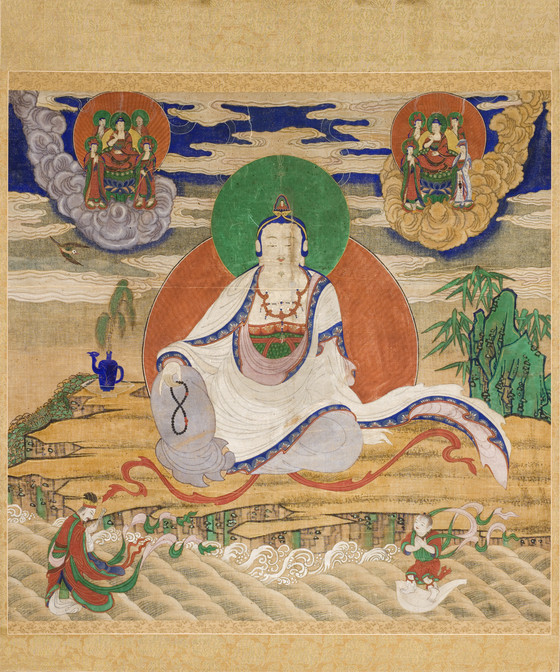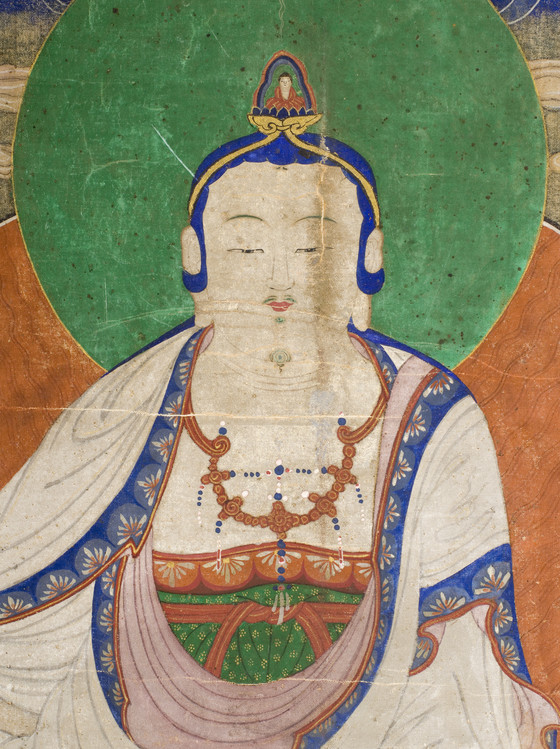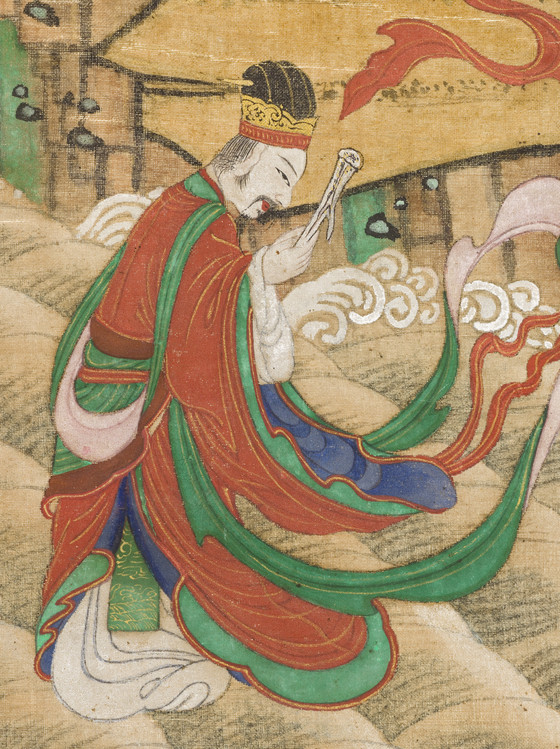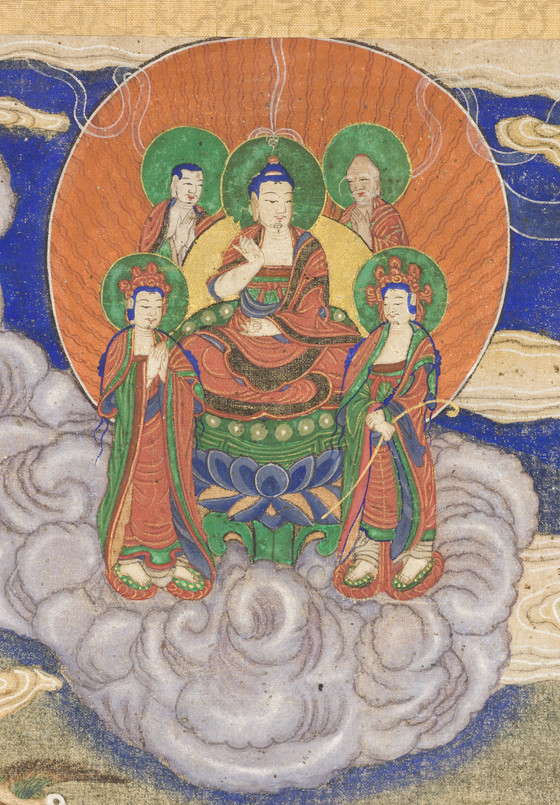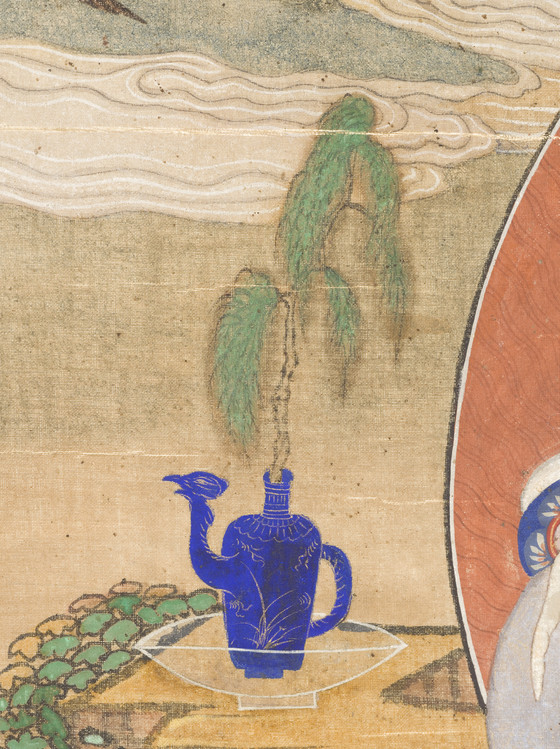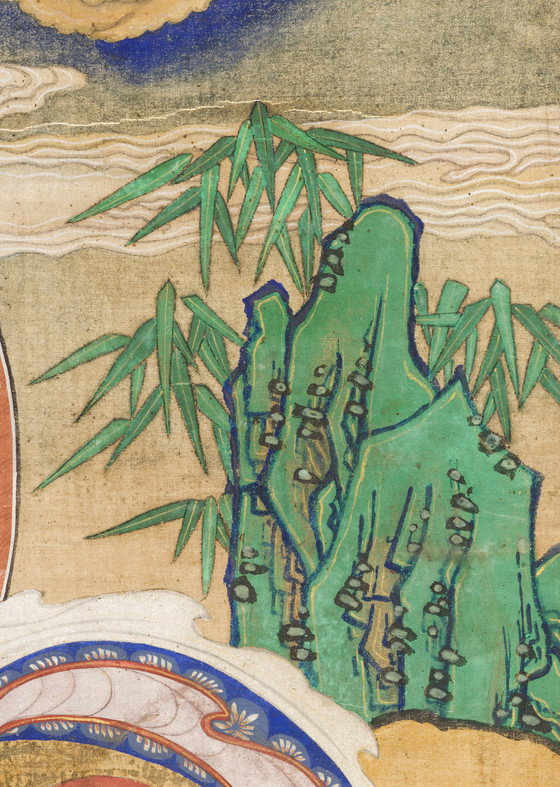Curator Notes
The primary role of Gwaneum (Sanskrit: Avalokiteshvara),[1] the bodhisattva of Compassion, is to save sentient beings, deliver them from their sufferings, and guide them to Nirvana. Many sutras describe the characteristics and accomplishments of Gwaneum, including the Sutra of Immeasurable Life (Muryangsugyeong), the Lotus Sutra (Myobeop yeonhwagyeong), and especially the chapter entitled “The Youth Seonjae Meets His First Teacher (Ipbeopgyepum)” in the Flower Garland Sutra (Hwaeomgyeong).
There are approximately thirty known paintings of Gwaneum from the Goryeo dynasty, including a painting from 1323 currently in the collections of the Sen-oku Hakuko kan, Kyoto, Japan. Although many Gwaneum paintings from the Goryeo period adhered to a standard composition, some artists created works that were less traditional. A painting of Gwaneum at the Museum Yamatobunkakan in Nara, Japan, depicts the bodhisattva facing forward; a Goryeo dynasty painting from1310 at Kagami Jinja, also in Nara, shows the deity facing left (fig. 1); and a painting at Sensoji in Asakusa, Japan, depicts Gwaneum standing.[2]
Similarly, there are only about thirty extant paintings of Gwaneum produced during the Joseon period, although many more are believed to have been created, despite the government’s official support for Confucianism and rejection of Buddhism.[3] This suggests that belief in Gwaneum was strongly persistent throughout all periods and among all classes. Artists in the Joseon period began to portray Gwaneum in a variety of poses, in addition to the half-lotus position (bangajwa) seen in paintings from Goryeo period: the bodhisattva was shown, for example, with legs half crossed and one knee raised (yunwangjwa), with legs completely crossed (gyeolgabujwa), and standing. Artists also began to include more characters, including the King and Queen of the Sea, birds, other Buddha images, Witaecheon, and Buddhist guardian deities such as the four heavenly guardians of Buddhism.[4]
In a scene described in the Flower Garland Sutra, Gwaneum greets the disciple Sudhana (Seonjae dongja), who was on a journey seeking knowledge. This event – which is the subject of the LACMA painting – became the basis for the most common depiction of Gwaneum during the Goryeo period in Korea. Gwaneum is shown sitting on a rock probably intended to be Mount Botarak, the mountain near the ocean where the deity was believed to reside, and waves can be seen in the foreground. Holding Buddhist prayer beads in the right hand, the deity is in the yunwangjwa pose, facing forward. A green nimbus can be seen around the head, and a larger red nimbus surrounds the body. A water vessel (jeongbyeong), in blue, has a spout in the shape of a phoenix head; a willow branch has been placed in the vessel, which sits in a transparent bowl (det. 1). At the bottom left is the King of the Eastern Sea (det. 2); at the bottom right is Seonjae dongja, who holds his hands together and stands on a lotus (det. 3). At top left, on the purple cloud, is the Trinity of Buddha Shakyamuni (Seokga samjon), with Anan (Sanskrit: Ananda) and Gaseop (Sanskrit: Mahakasyapa), two disciples of Buddha (det. 4). At top right, on the yellow cloud, is the Trinity of Buddha Amitabha (Amita samjon)[5] with two additional bodhisattvas (det. 5).
One distinctive characteristic of this painting is Gwaneum’s yunwangjwa pose.[6] This pose was first introduced in Daoist imagery[7] during China’s Northern Wei period (386-534/5). In Korea, the yunwangjwa was the most common pose shown in paintings of the Joseon period, and examples can be seen in Thirty-two Responsive Manifestations of Gwaneum of Dogap Temple from 1550 by Jasil Lee, currently in the collection of Chion’in temple in Kyoto, Japan (fig. 2); in works by the renowned eighteenth-century monk artist Euigyum, from 1730 at Unheung Temple, South Gyeongsang province (fig. 3) and from 1723 at Heungguk Temple, South Jeolla province; and in the painting of Gwaneum from 1858 at Tongdo Temple, South Gyeongsang province.
The inclusion of trinities of the Buddha (Yeorae samjon) is unusual in known paintings of Gwaneum, although a similar composition from 1897 exists in Beopju Temple, North Chungcheong province (fig. 4). In the Beopju Temple painting, however, Buddha is shown seated with a lotus near the pedestal and different guardians. These differences are presumed to be the result of disorganization in the iconography of the late Joseon period.
A water vessel with a similar phoenix-head-shaped spout also appears in a painting of Buddha from 1886 at Hwagye Temple, Seoul, Gyeonggi province, although the one seen in the LACMA painting is more formalized. This type of decoration also appears on a kettle and vase in a painting of sixteen nahans from1884 at Jingwan Temple, Seoul, Gyeonggi province, leading scholars to believe it was popular in the Gyeonggi province at the end of the nineteenth century.
This hanging scroll was painted with ink, color, and gold on cotton. Gwaneum’s face is square with small features; a line of brown color was used for the facial features (det. 6). Yellow ocher was used for the flesh, and white pigment was used for the robes. Ink was applied to create the creases of the robe. The vermilion, blue, and dark blue border of the robe were first sketched with ink, then painted with pigment, and finally embellished with gold paint. An image of Buddha sits inside the diadem that Gwaneum wears as a crown. The relatively large ornaments on Gwaneum’s neck are standard iconography. Yellow ocher, white, and violet pigments were used for most of the background elements, such as the rock, clouds, and waves, with ink used to create details. A flower pattern, including gold-painted petals, was created on Gwaneum’s violet garment. The edge of the red scarf has a repeated pattern of a semicircular flower.
The year of the painting is not known, because the painting’s inscription no longer exists. However, its spacious composition, intricate details, and the use of blue, vermillion, and blue-green, position it stylistically within the late nineteenth or early twentieth century.
Footnotes
[1] In Sanskrit, the name Avalokiteśvara was created by combining Avarokita (the Sanskrit word for “crown” or “deity”) with iśvara, which refers to Maheśvara, a deva (deity). In Korea, Avalokiteśvara is called Gwaneum, although the names Gwangseeum, Gwanseeum, and Gwansejajae are also used.
[2] WooThak Chung, “Icons and beauties of Buddhist paintings of Goryeo,” 25-26.
[3] Only paintings featuring Gwaneum by alone are included in the thirty; those depicting Gwaneum as an attendant to the Buddha (Yeorae) are excluded.
[4] Jiyeong Lee, “Study on the Painting of Gwaneum Bosal in the Joseon Dynasty,” 101.
[5] In the Trinity of Buddha Shakyamuni (Seokga samjon), Shakyamuni Buddha is at the center accompanied by his attendants, Munsu (Sanskrit: Manjushri) and Bohyeon (Sanskrit: Samantabhadra). The Trinity of Buddha Amitabha (Amita samjon) has Buddha Amitabha at the center, attended by Jijang (Sanskrit: Kshitigarbha) and Gwaneum (Sanskrit: Avalokiteshvara).
[6] The yunwangjwa position is assumed by first sitting in full cross-legged pose, then putting the right knee up with the right hand on top it. The left leg remains in the crossed position, and the left hand is placed at the rear of the left leg.
[7] Eunwoo Chung, “Study of Buddhist Sculptures in the Late Goryeo Dynasty+,” 58-59.
Bibliography
Buddhist Cultural Properties Research Institute. Buddhist Paintings of Korea [Hanguk ui bulhwa], vol. 1-36. Yangsan, South Gyeongsang province: Buddhist Cultural Properties Research Institute, 1999.
Chung, Eunwoo. “Study of Buddhist Sculptures in the Late Goryeo Dynasty [Goryeo hugi bulgyo jogak yeongu].” PhD, Hongik University, 2001.
Chung, WooThak. “Icons and beauties of Buddhist paintings of Goryeo [Goryeo bulhwa ui dosang gwa areumdaum].”Buddhist Paintings of the Goryeo Dynasty [Goryeo sidae ui bulhwa]. Seoul: Sigongsa, 1997.
Lee, Jiyeong. “Study on the Painting of Gwaneum Bosal in the Joseon Dynasty [Joseon sidae gwaneum bosaldo ui yeongu].” Master’s thesis, Dongguk University, 2004.
Additional References
Kim, Hongnam. The Story of a Painting: A Korean Buddhist Treasure from The Mary and Jackson Burke Foundation. New York: The Asian Socity Galleries, 1991, 31, Fig. 29/No. 23, 31 Kim, Hongnam. The Story of a Painting: A Korean Buddhist Treasure from The Mary and Jackson Burke Foundation. New York: The Asian Socity Galleries, 1991, 31, Fig. 29/No. 23, 31
More...
Bibliography
- Woo, Hyunsoo, ed. Treasures from Korea: Arts and Culture of the Joseon Dynasty, 1392-1910. Philadelphia: Philadelphia Museum of Art, 2014.
- Kim, Hongnam. The Story of a Painting: A Korean Buddhist Treasure from The Mary and Jackson Burke Foundation. New York: The Asian Socity Galleries, 1991.
- Korean Art Collection of the Los Angeles County Museum of Art, U.S.A. Daejeon, Republic of Korea: National Research Institute of Cultural Heritage, 2012.
- Muchnic, Suzanne. LACMA So Far: Portrait of a Museum in the Making. San Marino, California: Huntington Library, Art Collections, and Botanical Gardens, 2015.
